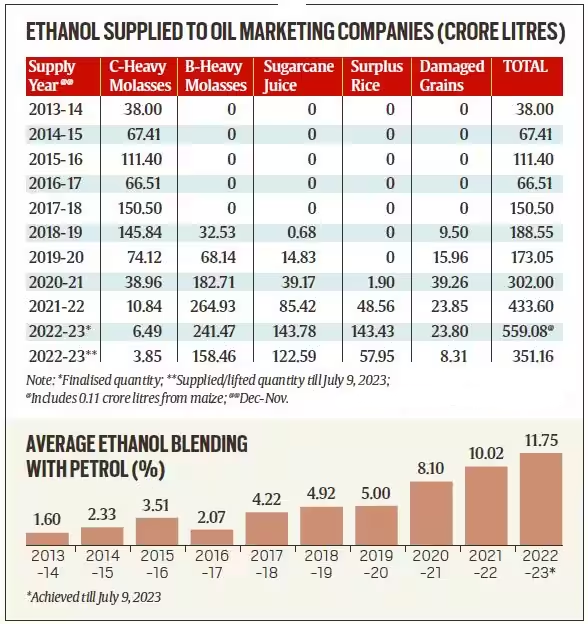Indian Economy
Ethanol
- 26 Jul 2023
- 7 min read
For Prelims: Ethanol, National Policy on Biofuels 2018, E100 Pilot project, Ethanol Blending Programme, Distillers' Dried Grain with Solubles
For Mains: Ethanol Blending and its significance
Why in News?
Recently, the Indian Prime Minister announced at the G20 Energy Ministers' meeting that India has rolled out 20% ethanol-blended petrol in 2023 and aims to cover the entire country by 2025.
- India's ethanol production has diversified from cane molasses to various feedstocks like rice, maize, and other grains.
- This move is part of India's commitment to reducing dependence on fossil fuels and promoting sustainable energy solutions.
What is Ethanol?
- About:
- Ethanol, also known as ethyl alcohol, is a biofuel produced from various sources such as sugarcane, corn, rice, wheat, and biomass.
- The production process involves the fermentation of sugars by yeasts or via petrochemical processes such as ethylene hydration.
- Ethanol is 99.9% pure alcohol that can be blended with petrol to create a cleaner fuel alternative.
- Apart from being a fuel additive, ethanol production yields valuable byproducts like Distillers' Dried Grain with Solubles, and Potash from Incineration Boiler Ash that find applications across various industries.
- Byproducts of Ethanol Production:
- Distillers' Dried Grain with Solubles (DDGS):
- DDGS is a byproduct of grain-based ethanol production.
- It is the residue left after the starch in grains is fermented and ethanol is extracted.
- DDGS is a valuable animal feed with high protein content and is used to supplement livestock diets.
- Potash from Incineration Boiler Ash:
- The ash remaining after Ethanol Production in the boiler contains up to 28% potash.
- This ash is a rich source of potash and can be utilized as a fertilizer.
- Distillers' Dried Grain with Solubles (DDGS):
- Applications of Ethanol as Fuel:
- Ethanol is used as a renewable and sustainable biofuel alternative to gasoline in the transportation sector.
- It can be blended with petrol in various proportions, such as E10 (10% ethanol, 90% petrol) and E20 (20% ethanol, 80% petrol).
- The Indian government has implemented the Ethanol Blending Programme to promote the use of ethanol as a renewable fuel.
- The program aims to blend ethanol with petrol to reduce the country's dependence on imported crude oil, cut carbon emissions, and boost farmers' incomes.
- Ethanol blends help reduce greenhouse gas emissions and air pollutants, contributing to cleaner air and mitigating climate change.
How has India Diversified its Feedstocks?
- Feedstock Diversification:
- Ethanol production in India was mainly based on 'C-heavy' molasses, with a sugar content of 40-45%, yielding 220–225 liters of ethanol per tonne.
- India explored direct sugarcane juice for ethanol production, increasing yield and efficiency.
- The country diversified its feedstocks by including rice, damaged grains, maize, jowar, bajra, and millets.
- Ethanol yields from grains are higher compared to molasses, with rice producing 450-480 liters and other grains 380-460 liters per tonne.
- Sugar mills diversified to use rice, damaged grains, maize, and millet as feedstocks.
- Leading sugar companies installed distilleries that can operate on multiple feedstocks throughout the year.
- The government's differential pricing policy played a crucial role in incentivizing the use of alternative feedstocks. By fixing higher prices for ethanol produced from certain feedstocks, mills were compensated for reduced sugar production.
- From 2018-19, the Indian government began fixing higher prices for ethanol produced from B-heavy molasses and whole sugarcane juice/syrup.
- Challenges:
- Grains yield more ethanol but require longer processing. The starch in the grain has to first be converted into sucrose and simpler sugars (glucose and fructose), before their fermentation into ethanol by using yeast (saccharomyces cerevisiae). Molasses already contain sucrose, glucose, and fructose.
- Quality variability of feedstocks affecting production.
- Environmental concerns related to non-traditional feedstocks.
- Benefits:
- Diversification of feedstocks will minimize supply fluctuations and price volatility on account of any one crop.
- The incorporation of new feedstocks for ethanol production can create new demand for grains.
Types of Molasses:
- A Molasses (First Molasses): An intermediate by-product from initial sugar crystal extraction, containing 80-85% dry matter (DM). Should be inverted to prevent crystallization if stored.
- B Molasses (Second Molasses): Similar DM content as A molasses but with less sugar and no spontaneous crystallization.
- C Molasses (Final Molasses, Blackstrap Molasses, Treacle): The end by-product of sugar processing, containing significant amounts of sucrose (about 32 to 42%). It does not crystallize and is used as a commercial feed ingredient in liquid or dried form.
What are the Government Initiatives to Promote Ethanol Blending in India?
- National Policy on Biofuels 2018
- E100 Pilot project
- Pradhan Mantri JI-VAN Yojana 2019
- Repurpose Used Cooking Oil (RUCO)
UPSC Civil Services Examination, Previous Years Questions (PYQs)
Q. According to India’s National Policy on Biofuels, which of the following can be used as raw materials for the production of biofuels? (2020)
- Cassava
- Damaged wheat grains
- Groundnut seeds
- Horse gram
- Rotten potatoes
- Sugar beet
Select the correct answer using the code given below:
(a) 1, 2, 5 and 6 only
(b) 1, 3, 4 and 6 only
(c) 2, 3, 4 and 5 only
(d) 1, 2, 3, 4, 5 and 6
Ans: (a)
- The National Policy on Biofuels, 2018, allows production of ethanol from damaged food grains like wheat, broken rice, etc., which are unfit for human consumption.
- The Policy also allows conversion of surplus quantities of food grains to ethanol, based on the approval of the National Biofuel Coordination Committee.
- The Policy expands the scope of raw material for ethanol production by allowing use of sugarcane juice, sugar containing materials like sugar beet, sweet sorghum, starch containing materials like corn, cassava, damaged food grains like wheat, broken rice, rotten potatoes, unfit for human consumption for ethanol production. Hence, 1, 2, 5 and 6 are correct. Therefore, option (a) is the correct answer.





